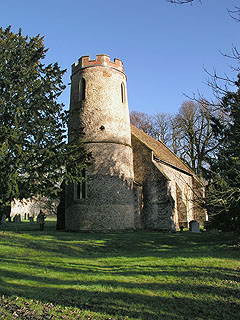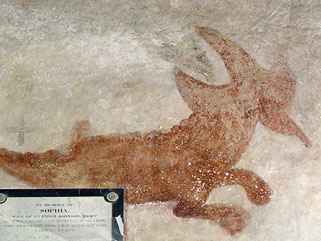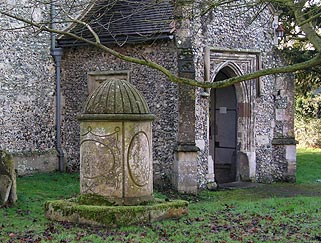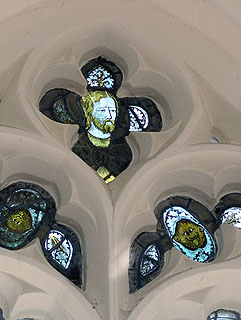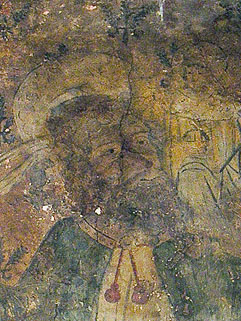Yes, it's round.
Round towers are mainly an East Anglian phenomenon, Norfolk and Suffolk have the lion's share with 120 and 43 respectively. They are something of a rarity in Cambridgeshire, only two survive - here at Bartlow and north of Newmarket at Snailwell. There was at least one more at Westley Waterless until 1855. It's probably no co-incidence that all three villages are very close to the Suffolk border.
To find an explanation for this odd tower then, we should probably cast our eyes eastwards. Even with the amount of study that has been lavished on the Norfolk and Suffolk round towers they remain something of a conundrum. Almost all are very old, a surprising proportion showing signs of Saxon work. This has led some people to suggest that they were originally lookout posts and fortifications, built to protect people against the encroachments of the Vikings, and had churches built up against them later. Neither of the surviving Cambridgeshire examples are as old as those - nor as solid-looking as something like the brooding mass at Wortham in Suffolk (which has a similarity to the great defensive brochs of Scotland and Ireland).
It is a tempting thought, and I have no doubt that churches were used as refuges in times of trouble, since they were often the only solid and defensible buildings in a settlement. Nevertheless, the Viking raids had finished long before the earliest of the round towers - by the late 10th and early 11th centuries the Danes had gained effective control of most of eastern England, and the east coast (and inland ports) were links in a trade network that tied us peacefully into a loose Scandinavian empire. By this stage, there would have been little need for defense. Moreover, aside from the detached tower at Bramfield (also in Suffolk) there's no evidence of such a tower having been built without a church. In many cases, the towers are younger than the churches.
The most likely explanation seems to be economics - in a part of the world where good building stone is hard to find, square towers, with their need for stone at the corners, were very expensive. Round towers, on the other hand, could be built from flint, fieldstones and rubble - indeed, anything that could be found in the area. Bartlow, for example, is built mainly from flint, with some fieldstones and patched up in places with brick. Economy cannot be the only consideration - there are parts of Cambridgeshire considerably more stone-starved than the eastern downs - but it would explain why they were relatively common, relatively early. Later on, perhaps fashion played a part.
My favourite theory of all is the utterly ridiculous one that the towers were originally wells, and were exposed when the land was washed away, either by erosion or by a flood depending on which version you hear. A striking image, but a trifle unlikely. For more information, I strongly recommend that you visit the Round Tower Churches Society website which is the source for most of what I've written here.
So, returning to the matter in hand, what can we say about Bartlow? This tower is Norman, rather than Saxon. I prefer it to its cousin at Snailwell - this is taller, and tapers unevenly towards the top where it is crowned with a much later octagonal brick parapet complete with little battlements. There are tiny quatrefoil windows dotted around the upper stages, and the simple bell-openings are filled with rather dishevelled grilles of wooden slats. The Decorated west window lower down was inserted later. If it were possible for a tower to be relaxed, this is it.
We entered through the north porch, whose inner and outer doorways are a fine matched pair from the 15th or 16th century. I see the type so often (a rectangular frame with a broad flat Perpendicular arch and some decoration in the spandrels) that I wonder whether they weren't mass-produced and shipped to churches to be assembled by masons on the site - certainly there is a remarkably regularity of design across the region. The same thing (though a little grander) can be seen at Little Chishill.
Inside, we were greeted by a mass of scaffolding and a radio blaring out what sounded like Whitney Houston's greatest hits. It looks like the roof was being restored - thankfully the two men working there didn't mind us wandering around.
St Mary is a dark, small church, all Decorated in style, but restored quite heavily in 1879 according to Pevsner. There are some fine earlier survivals however. In the chancel, there are bits of medieval glass surviving in the tops of the windows. There are some coats of arms and bits and bobs of architectural detail which must once have formed canopies for images of saints. More exciting are the leering demons' heads in the tracery above, and some sad looking heads of Christ and angels. They are delicately painted, and rather fine - what a pity that more doesn't survive.
Dowsing did for at least a few of them on the 20th of March 1643 when he and his friends: ' brake down a crucifix, and a Holy Lamb, and 10 superstitious pictures, and gave order to take downe three crosses in stone, and to level the steps'. It's unlikely that he would have seen the fine 15th century wall-paintings in the nave, as these had probably been whitewashed in the first flush of Protestant iconoclasm the century before. A few bits and bobs have now been uncovered.
In his usual position opposite the south door, St Christopher gazes down at us. Only his head and shoulders remain, and the whole thing is covered in a dark brown haze that looks like the consequence of a botched conservation job (I believe that it was once considered wise to cover paintings with beeswax to preserve them from decaying once exposed to the air - only subsequently was it discovered that this not only had a tendency to damage the pigment, but also that the wax would darken and obscure the picture). The saint here hasn't faired as badly as some - it is still possible to make out his cloak and staff and the smile he directs up to the child on his shoulder. Christ himself is dressed in a rich robe of pale blue and gold, with an ermine mantle, and carries an orb as the symbol of his dominion.
To the west of the pair, there is a fainter painting of St Michael weighing the souls of the dead. By his side, the Virgin Mary stands interceding for sinners - a favourite subject in England (a country so enthusiastically Marian in its devotions that it was known as the Virgin's Dowry) .
My favourite painting in the church, though, is a great dragon opposite St Christopher. it must once have had a St George standing above it, but he has gone, and the whole thing is very faced - the dragon survives only as a silhouette, and we can only see bits of the background, strange dark crosses and shapes that could be puffy red flowers. He's a very fine dragon, though, huge-horned and wide-mouthed. Pevsner described him as 'ferocious and antediluvially large'.
St Mary was open when we visited.
